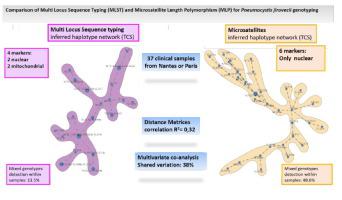Computational and Structural Biotechnology Journal ( IF 4.4 ) Pub Date : 2020-10-15 , DOI: 10.1016/j.csbj.2020.10.005 Maud Gits-Muselli , Pascal Campagne , Marie Desnos-Ollivier , Patrice Le Pape , Stéphane Bretagne , Florent Morio , Alexandre Alanio

|
Pneumocystis jirovecii is an atypical fungus responsible for severe respiratory infections, often reported as local outbreaks in immunocompromised patients. Epidemiology of this infection, and transmission risk emphasises the need for developing genotyping techniques. Currently, two methods have emerged: Multilocus sequence typing (MLST) and microsatellite length polymorphism (MLP). Here we compare an MLST strategy, including 2 nuclear loci and 2 mitochondrial loci, with an MLP strategy including 6 nuclear markers using 37 clinical PCR-positive respiratory samples from two French hospitals. Pneumocystis jirovecii MLST and MLP provided 30 and 35 different genotypes respectively. A higher number of mixed infections was detected using MLP (48.6% vs. 13.5% respectively; p=0.002). Only one MLP marker (STR279) was statistically associated with the geographical origin of samples. Haplotype network inferred using the available genotypes yielded expanded network for MLP, characterized by more mutational steps as compared to MLST, suggesting that the MLP approach is more resolutive to separate genotypes. The correlation between genetic distances calculated based on MLST and MLP was modest with a R2 value = 0.32 (p<0.001). Finally, both genotyping methods fulfilled important criteria: (i) a discriminatory power from 97.5% to 99.5% and (ii) being quick and convenient genotyping tools. While MLP appeared highly resolutive regarding genotypes mixture within samples, using one genotyping method rather than the other may also depend on the context (i.e., MLST for investigation of suspected clonal outbreaks versus MLP for population structure study) as well as local facilities.
中文翻译:

吉氏肺孢子虫基因分型的多基因座序列分型(MLST)和微卫星长度多态性(MLP)比较
吉氏肺孢子虫是一种非典型真菌,负责严重的呼吸道感染,通常被报告为免疫功能低下患者的局部暴发。这种感染的流行病学和传播风险强调需要开发基因分型技术。当前,出现了两种方法:多基因座序列分型(MLST)和微卫星长度多态性(MLP)。在这里,我们使用来自两家法国医院的37种临床PCR阳性呼吸道样本,比较了包括2个核基因座和2个线粒体基因座的MLST策略与包括6个核标记的MLP策略。吉氏肺孢菌MLST和MLP分别提供30和35个不同的基因型。使用MLP检出的混合感染数量更高(分别为48.6%和13.5%;p= 0.002)。统计上只有一个MLP标记(STR279)与样品的地理来源相关。使用可用基因型推导的单倍型网络产生了MLP的扩展网络,与MLST相比,其特征在于更多的突变步骤,这表明MLP方法对于分离基因型更具分辨力。基于MLST和MLP计算的遗传距离之间的相关性很小,R 2值= 0.32(p<0.001)。最后,两种基因分型方法均满足重要标准:(i)从97.5%到99.5%的判别力,以及(ii)快速便捷的基因分型工具。虽然MLP在样品中的基因型混合方面表现出很高的分辨力,但使用一种基因分型方法而不是另一种基因分型方法也可能取决于具体情况(例如,MLST用于调查可疑的克隆暴发,而MLP用于种群结构研究)以及当地设施。











































 京公网安备 11010802027423号
京公网安备 11010802027423号